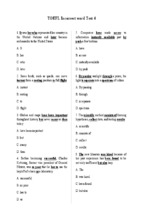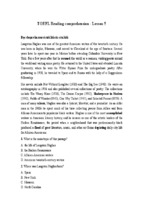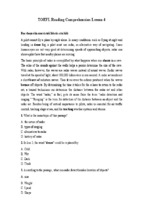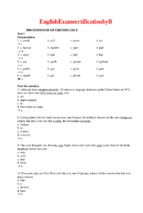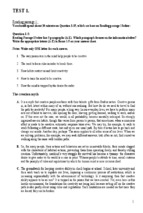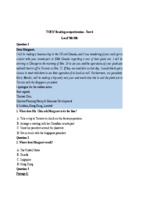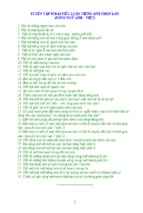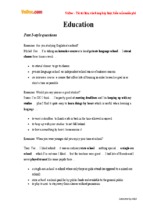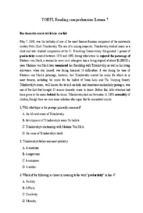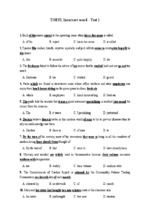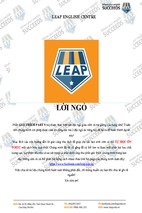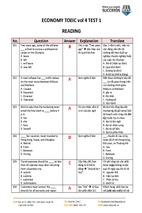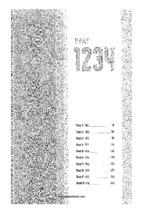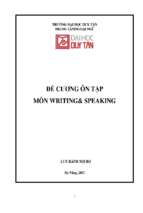OCCUPATIONAL SAFETY BEHAVIOR IN WORKPLACE OF
PRODUCTON COMPANY IN HANOI: BASIS FOR
ACCIDENT PREVENTION AND REDUCTION
___________________________
A DISSERTATION
Presented to the Faculty of the Graduate School
Southern Luzon State University, Lucban, Quezon, Philippines
in Collaboration with
Thai Nguyen University, Socialist Republic of Vietnam
___________________________
In Partial Fulfillment
of the Requirements for the Degree
Doctor of Business Administration
___________________________
By
PHAM THI NINH (SUE)
December 2013
i
APPROVAL SHEET
The Dissertation of
PHAM THI NINH
entitled
OCCUPATIONAL SAFETY BEHAVIOR IN WORKPLACE OF PRODUCTON
COMPANY IN HANOI: BASIS FOR ACCIDENT PREVENTION
AND REDUCTION
Submitted in Partial Fulfilment of the Requirements for the Degree
DOCTOR OF BUSINESS ADMINISTRATION
A program offered by Southern Luzon State University,
Republic of the Philippines in collaboration with
Thai Nguyen University, Socialist Republic of Vietnam
has been approved by Oral Examination Committee
JOANNA PAULA A. ELLAGA, DBA
Expert
EDWIN P. BERNAL, DBA
Expert
NELLY I. MENDOZA, DBA
Expert
ALICE T. VALERIO, PhD
External Panel
CECILIA N. GASCON, PhD
Chairman
Endorsed by:
Recommended by:
MELCHOR MELO O. PLACINO, PhD
Adviser
APOLONIA A. ESPINOSA, PhD
Dean
Accepted in Partial Fulfilment of the Requirements for the Degree
Doctor of Business Administration
_____________________
Date
WALBERTO A. MACARAAN, EdD
Vice President for Academic Affairs
ii
CERTIFICATE OF ORIGINALITY
This is to certify that the dissertation entitle “ OCCUPATIONAL SAFETY
BEHAVIOR IN WORPLACE OF PRODUCTION COMPANY IN HANOI:
BASIS FOR ACCIDENT PREVENTION REDUCTION”, orally defended/
presented under the DBA Program jointly offered by Southern Luzon State
University of the Republic of the Philippines and Thai Nguyen university of the
Socialist Republic of Vietnam, embodies the result of original and scholarly
work carried out by the undersigned.
This dissertation does not contain works or ideas taken from published
sources or written works by other persons which have been accepted as basis
for the award of any degree from other higher education institution, except
where proper referencing and acknowledgement were made.
Researcher/ Candidate
Pham Thi Ninh
Date Orally Defended:
October 2014
iii
ACKNOWLEDGMENT
I would like to express my most sincere thanks to the Management Board of
the Southern Luzon State University, Thai Nguyen University, and the teachers in the
said schools for helping me in the learning process throughout.
I would like to express my sincere gratitude and profound appreciation to
Professor Melchor Melo Placino, my enthusiastic teacher for his guidance and
encouragement, and the time he spent for this research.
I would also like to express my sincere thanks to the Department of
Employment - Ministry of Labor - Invalids and Social Affairs, the LILAMA 69-2
company that has helped me for my research material, through a questionnaire
survey.
I sincerely thank the Board of the University of Labor and Social affair
(ULSA), colleagues in ULSA, and classmates in DBA1 who offered enthusiastic help
and shared help complete the thesis.
Finally, I would like to send my thanks from the heart, to my family for their
enthusiasm and encouragement to complete my thesis.
PTN
iv
DEDICATION
I wish to dedicate this dissertation to my family and friends.
PTN
v
TABLE OF CONTENTS
PAGE
TITLE PAGE ………………………………………………………………..
i
APPROVAL SHEET ……………………………………………………….
ii
CERTIFICATE OF ORIGINALITY ………………………………………..
iii
ACKNOWLEDGEMENT …………………………………………………..
iv
DEDICATION ………………………………………………………………
v
TABLE OF CONTENTS …………………………………………………..
vi
LIST OF TABLES ………………………………………………………….
viii
LIST OF FIGURES ………………………………………………………...
ix
LIST OF APPENDICES …………………………………………………...
x
ABSTRACT …………………………………………………………………
xi
CHAPTER
I
1
Statement of the Problem ………………………………..
3
Objectives of the Study …………………………………..
4
Significance of the Study …………………………………
4
Scope and Limitations of the Study ……………………..
5
Definition of Terms ………………………………………..
5
REVIEW OF LITERATURE ……………………………….
7
Conceptual Framework ……………………………………
III
1
Background of the Study …………………………………
II
INTRODUCTION ………………………………………….
36
METHODOLOGY
Research Design ……………………………….…………..
37
Locale of the Study ……………………………………..…..
39
Data Gathering Procedure …………………………………
40
Population, Sample and Sampling Technique ………
40
Research Instrument ……………………………………
41
Statistical Analysis………………......................................
41
Statistical Treatment ……………………………………
43
vi
IV
RESULTS AND DISCUSSIONS ………………………….
V
43
SUMMARY, CONCLUSIONS AND
RECOMMENDATIONS
Summary ……………….……………………………………
69
Conclusions …………………………………………………
71
Recommendations …………………………………………
72
REFERENCES ……………………………………………………………..
73
APPENDICES ……………………………………………………………...
75
CURRICULUM VITAE …………………………………………………….
83
vii
LIST OF TABLES
TABLE
PAGE
1
Report of Labor Accident in 2011
35
2
Safety Behavior Marking from Workers’ Responses
44
3
T-test Paired Two Sample for Mean
45
4
Result Survey of Managers and Supervisors
45
5
Workers’ Personal Profile
46
6
Types of Accident in 3 Years
47
7
The Causes that Lead to Accident in LILAMA
48
8
Summary Result of Area D, PATS, SATS, SATW
49
9
Summary of Result of Areas: D, PATS, SATS, HSE
51
10
The Example of Critical Behaviors
63
11
The Example of BSV Checklist and Analysis
65
12
How to do BBS observation (BSV)
66
viii
LIST OF FIGURES
FIGURE
PAGE
1
Perception and it’s Important for Organizational Behavior
10
2
Attribution Theory
13
3
Maslow’s Hierarchy of Needs
17
4
Conceptual Framework of the Study
36
5
Paradigm of the Study
36
6
Graph on Respondent’s Answer
44
7
Comparison of the Responses of Managers-Supervisors
and Worker
53
BBS Process
63
8
ix
LIST OF APPENDICES
APPENDIX
PAGE
A
Survey Questionnaire
76
B
Table of T-test
79
C
Summary Response of Workers
82
`
x
ABSTRACT
Title of Research
: OCCUPATIONAL SAFETY BEHAVIOR IN
WORKPLACE OF PRODUCTON COMPANY IN
HANOI: BASIS FOR ACCIDENT PREVENTION
AND REDUCTION
Researcher
: PHAM THI NINH (SUE)
Degree Conferred
: DOCTOR OF BUSINESS ADMINISTRATION
Name and Address
of Institution
: Southern Luzon State University Lucban, Quezon,
Philippines and Thai Nguyen University, Socialist
Republic of Vietnam
Adviser
: Dr. Melchor Melo O. Placino
Year Written
: 2013
______________________________________________________________
Safety issues in the workplace are urgent problems nowadays,
because unsafe conditions occur in the daily work in the company, especially
in the manufacturing sector. Studies show that about 90% of accidents occur
because of unsafe behavior and human errors. Even if workers do not have
the right knowledge, attitude and behavior toward safety measures in a safe
workplace, all efforts for an accident-free workplace will be in vain. This study
aims is to determine the effectiveness of current safety programs in the
company and recommend to create a safety training program on behavioral
safety for accident reduction in one typical local big company in manufacturing
and building sector.
This descriptive cross- sectional study was carried out on workers/
managers in LILAMA 69-2 company. A sample size of 394 was randomly
selected. The data collection tool was a researcher–made questionnaire. Data
was analyzed using Microsoft Excel.
xi
With the findings from the study about the causes leading to accident,
safety attitude and safety climate, workplace safety behaviors, the researcher
believe to help the company management and also other local similar
enterprises to improve safety program especially with launching Behavior
Based Safety training program and finally to improve accident rate in
workplace.
xii
1
Chapter I
INTRODUCTION
Safety behavior presents a paradox to practitioners and researchers
alike because contrary to the assumption that self-preservation overrides
other motives (Maslow, 1970), careless behavior prevails during many routine
jobs, making safe behavior an ongoing managerial challenge. Studies in
industrialized countries showed that about 90% of accidents occur because of
unsafe behavior and human errors and only 10% of those belong to
unsuitable workplace and equipment (Ghofranipour, 2009:125). Even if
workers do not have the right knowledge, attitude and behavior toward safety
measures in a safe workplace, all efforts for an accident-free workplace will be
in vain. Clearly, therefore, safe behavior in routine work poses managerial
challenges.
Background of the Study
As stated in some previous study from various researchers, the causes
that lead to accidents have been changing in time. From higher rates of
accident on engineering system, now human factor contributes mostly to
accident causes. Changing the behavior of employee is challenge of
manager.
In the case of Vietnam, occupational accident is a very important issue
in industries. In recent years, the number of occupational accidents occurring
more and more in industries is growing.
2
Also, according to the report of the MOLISA (Ministry of labor, invalid
and social affairs), the material damage caused by occupational accidents
occurring in the first 6 months of 2011 (expenses relating to medicine, funeral,
compensations for families of deaths and injury, ...) was 143.331.800.000 vnd
(2.62 times increase over the same period in 2010), damage to property was
17.609.900.000 vnd (7.89 times increase over the same period in 2010).
Accordingly, the causes of workplace accidents were due to no training
in occupational safety in Vietnam Industry on all of employees (7.8%),
presence of unsafe equipment (3.15%), employees ill-equipped with personal
protective gears (1.39%), and absence of procedures, safety measures
(3.49%). Thus more then 80% of accidents that occur can be attributed to
human factors – i.e. - the attitude, knowledge, and behavior of workers toward
safe work.
This is why the author considered conducting a research on one typical
local big company on the field of production and construction in Hanoi area.
The result of the study and recommendations could apply to others on the
same field and area.
The company selected was LILAMA 69-2 has more than 50 years of
constant development. It is known as one of the experienced companies for
vessels, pipe manufacturing and is a known construction contractor in
Vietnam.
Being well aware of the strict requirements from clients on the
high quality services, LILAMA 69-2 has been focusing on developing its
3
human resources including qualified technical employees and engineers
who graduated from the prestigious universities in Vietnam to be good in
both
technical qualification and manufacturing experiences as
well
as
investing more modernized facilities for manufacturing works at factory. The
number of employees by end of 2012 was 1,180 staff and 120 leaders and
managers. The company is 51% owned by the state, while 49% of the shares
are owned by private shareholders with 57 BVND per capital.
Despite the company’s safety policy of ensuring safety in production
with the target of Zero accident by providing safety training and occupational
health to 100% of its workers through daily supervision of safety and
occupational health, safety and occupational health status was recorded to be
in not good condition. This follows the report of LILAMA 692, in 2010, 2011,
2012, where there was only one (1) serious accident that led to death, but
many accidents or incidents were not formally recorded. The three years of
incident and investigation data showed that most of the workplace incidents
are triggered by unsafe behaviors and persistence of inherited traditional
beliefs and overconfidence of workers.
It is obvious that the safety management system in the company is top
down with very “state-owned training style”. The behavior based safety is
something not yet familiar within companies.
Statement of the Problem
In general, the study was aimed to determine the effectiveness of the
safety program and recommend safety training program on the safety
4
behavior of workers and the reduction or prevention of accident in a
production company in Hanoi, Vietnam.
Specifically it sought to answer the following questions:
1. What is the profile of workers in LILAMA 69-2 company
2. What
is
the
frequency
and
types/classification
of work-related
accidents in LILAMA 69-2 company?
3. What is the leading causes of work-related accident in LILAMA
company?
4. What is attitude of workers on safety and the safety climate in LILAMA
69-2?
5. What is the behavior of the management of LILAMA 69-2 towards
safety program in the company?
6. What safety program is appropriate to improve the safety behavior of
workers and safety climate in LILAMA 69-2?
Significance of the Study
This research on the behavioral safety in the workplace of production a
company in Hanoi area (LILAMA 69-2) establishes a behavior-based safety
training program for the company.
With research result about safety climate, culture and behaviors and by
introduction of Behavior Based Safety with its training program to managers
and employees, the study and training program arms to promote: (i) the
5
maintenance and promotion of workers’ health and working capacity; (ii) the
improvement of working environment and work to become conducive to safety
and health and (iii) development of work organizations and working cultures in
a direction which supports health and safety at work and in doing so also
promotes a positive social climate and smooth operation and may enhance
productivity of the undertakings.
Scope and Limitation of the Study
The research study is carried out in Vietnam and focused on LILAMA
69-2 which is operating in Hanoi area. This is the area where large amount of
industrial companies have reported many accidents.
With the fact that companies have different dimension about work
character, knowledge of employees, scale of company, the author chose one
typical local and big size company for the research. The result of this research
also could apply to other companies in the area and on the same field.
Definition of Terms
The following terms are defined conceptually and operationally:
BBS (Behavior Base Safety). BBS is a methodology to use scientific
psychology to understand why people behave to their way they do
when it come to safety. Typically it creates an attitude and awareness
that will reduce the chance of injury. BBS introduces systematic,
ongoing approach or process that clearly defines how people can
reduce the risk of injury to people in your work team
6
BBSO. Behavioral safety visit.
Benchmarking. A measurement of the quality of an organization's policies,
products, programs, strategies, etc., and their comparison with
standard measurements, or similar measurements of its peers.
BSV. Behavioral base safety observation.
Experienced worker. Any worker who has special skill, training, knowledge,
and (usually acquired) ability in their work.
Educated worker. A worker who has knowledge and has graduated from
technical school or higher.
Fatal accident. An accident which led to the death of one or more people
(temporary worker, trainee, contractor, client, patient, others, etc…).
Lost time accident. Occupational injury which prevents the individual from
reporting to work on the next scheduled workday following the
accident, or leads to a work interruption due to the accident some days
after the accident.
Non-lost time accident (also called “Other recordable accident“). An
accident of sufficient severity, as defined by local HSE regulations, that
must be recorded as an accident but that does not result in time lost. It
includes accidents where the person is able to return to work the same
day, or the day following the accident, following medical treatment.
Training. Training is the acquisition of knowledge, skills, and competencies
as a result of the teaching of vocational or practical skills and
knowledge that relate to specific useful competencies.
7
Chapter II
REVIEW OF LITERATURE
Through extensive data gathering from different books and internet
sites, this chapter serves as informative references of this research study
particularly focusing on its objectives. Different research studies have also
been found which are precisely significant to the development of the study.
Organizational Behavior
Organizational behavior is a field of study that investigates the impact
that individuals, groups, and structure have on behavior within organizations,
for the purpose of applying such knowledge toward improving an
organization’s effectiveness.
Organizational behavior is concerned with the study of what people do
in an organization and how that behavior affects the performance of the
organization. Because organizational behavior is specifically concerned with
employment related situations, then it emphasizes behavior as related to job,
work, productivity, human performance, and management. Organizational
behavior includes motivation, leader behavior, interpersonal communication,
group
structure
and
processes,
learning,
attitude
development
and
perception, change processes and work stress.
Behavior generally is predictable if we know how the person perceived
the situation and what is important to him or her. While people’s behavior may
not appear to be rational to an outsider, there is reason to believe it usually is
intended to be rational and it is seen as rational by them. An observer often
8
sees behavior as non-rational because the observer does not have access to
the same information or does not perceive the environment in the same way.
Certainly there are differences between individuals. Placed in similar
situations, all people do not act exactly alike. However, there are certain
fundamental consistencies underlying the behavior of all individuals that can
be identified and then modified to reflect individual differences. These
fundamental
consistencies
are
very
important
because
they
allow
predictability.
Developing an Organizational Behavior Model
A model is an abstraction of reality, a simplified representation of some
real world phenomenon (Robbin, Stephen, Organizational Behavior, eight
editions, A Simon and Schuster Company Upper Saddle River, New Jersey
07458). Stephen Robbins in his book “Organizational behavior” set up the
model with three levels of analysis: Individual level; Group level; and
Organizational system level. The three basis levels are analogous to building
blocks; each level is constructed upon the previous level. Group concepts
grow out of the foundation laid in the individual section, and then arrive at
organizational behavior.
The model of analysis of organizational behavior contents various
dependent variables and independent variables. Dependent variable is a
response that is affected by an independent variable. In this case productivity,
absenteeism, turnover and job satisfaction are dependent variable.
The
- Xem thêm -


